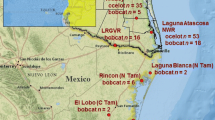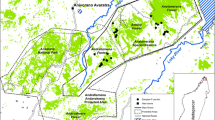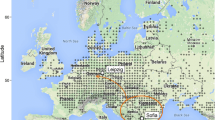Abstract
Populations rarely show immediate genetic responses to habitat fragmentation, even in taxa that possess suites of traits known to increase their vulnerability to extinction. Thus conservation geneticists must consider the time scale over which contemporary evolutionary processes operate to accurately portray the effects of habitat isolation. Here, we examine the genetic impacts of fragmentation on the Florida sand skink Plestiodon reynoldsi, a sand swimming lizard that is highly adapted to the upland scrub habitat of central Florida. We studied fragments located on the southern Lake Wales Ridge, where human activity in the latter half of the 20th century has modified the natural patchiness of the landscape. Based on a relaxed molecular clock method, we estimate that sand skinks have persisted in this region for approximately 1.5 million years and that the time frame of human disturbance is equivalent to fewer than 30 skink generations. Using genotypes from eight microsatellite loci, we screened for molecular signatures of this disturbance by assessing congruence between population structure, as inferred from spatially-informed Bayesian assignment tests, and the current geography of scrub fragments. We also tested for potential intrapopulation genetic effects of inbreeding in isolated populations by comparing the average pairwise relatedness of individuals within fragments of different areas and isolation. Our results indicate that although some patches show a higher degree of relatedness than expected under random mating, the genetic effects of recent isolation are not evident in this part of the species’ range. We argue that this result is an artefact of a time-lag in the response to disturbance, and that species-typical demographic features may explain the genetic inertia observed in these populations.





Similar content being viewed by others
References
Andrén H (1994) Effects of habitat fragmentation on birds and mammals in landscapes with different proportions of suitable habitat: a review. Oikos 71:355–366. doi:10.2307/3545823
Antoniak CE (1974) Mixtures of Dirichlet processes with applications to non-parametric problems. Ann Stat 2:1152–1174. doi:10.1214/aos/1176342871
Archie JW (1985) Statistical analysis of heterozygosity data: independent sample comparisons. Evol Int J Org Evol 39:623–637. doi:10.2307/2408657
Ashton KG (2005) Life history of a fossorial lizard, Neoseps reynoldsi. J Herpetol 39:389–395. doi:10.1670/148-04A.1
Berry O, Tocher MD, Gleeson DM, Sarre SD (2005) Effect of vegetation matrix on animal dispersal: genetic evidence from a study of endangered skinks. Conserv Biol 19:855–864. doi:10.1111/j.1523-1739.2005.00161.x
Bonnet E, Van de Peer Y (2002) zt: a software tool for simple and partial Mantel tests. J Stat Softw 7:1–12
Branch LC, Hokit DG (2000) A comparison of scrub herpetofauna on two central Florida sand ridges. Fla Sci 63:108–117
Branch LC, Clark AM, Moler P, Bowen BW (2003) Fragmented landscapes, habitat specificity, and conservation genetics of three lizards in Florida scrub. Conserv Genet 4:199–212. doi:10.1023/A:1023398908793
Brandley MC, Schmitz A, Reeder TW (2005) Partitioned Bayesian analysis, partition choice, and the phylogenetic relationships of scincid lizards. Syst Biol 54:373–390. doi:10.1080/10635150590946808
Brooks TM, Pimm SL, Oyugi JO (1999) Time lag between deforestation and bird extinction in tropical forest fragments. Conserv Biol 13:1140–1150. doi:10.1046/j.1523-1739.1999.98341.x
Caro T (2007) Behavior and conservation: a bridge too far? Trends Ecol Evol 22:394–400. doi:10.1016/j.tree.2007.06.003
Castellano S, Balleto E (2002) Is the partial Mantel test inadequate? Evol Int J Org Evol 56:1871–1873
Chen C, Durand E, Forbes F, Francois O (2007) Bayesian clustering algorithms ascertaining spatial population structure: a new computer program and a comparison study. Mol Ecol Notes 7:747–756. doi:10.1111/j.1471-8286.2007.01769.x
Christman SP (1992) Threatened: sand skink, Neoseps reynoldsi (Stejneger). In: Moler PE (ed) Rare and endangered biota of Florida. Volume III amphibians and reptiles. University of Florida Press, Gainesville
Christman SP (2005) Densities of Neoseps reynoldsi on the Lake Wales Ridge. Final report submitted to U.S. Fish and Wildlife Service, Vero Beach, FL
Clark AM, Bowen BW, Branch LC (1999) Effects of natural habitat fragmentation on an endemic scrub lizard (Sceloporus woodi): an historical perspective based on a mitochondrial DNA gene genealogy. Mol Ecol 8:1093–1104. doi:10.1046/j.1365-294x.1999.00653.x
Collazos A (1998) Microhabitat selection in Neoseps reynoldsi, the Florida sand swimming skink. Master’s Thesis, University of South Florida
Cornuet JM, Luikart G (1996) Description and power analysis of two tests for detecting recent population bottlenecks from allele frequency data. Genetics 144:2001–2014
Cowlishaw G (1999) Predicting the pattern of decline of African primate diversity: an extinction debt from historical deforestation. Conserv Biol 13:1183–1193. doi:10.1046/j.1523-1739.1999.98433.x
Davies KF, Margules CR, Lawrence JF (2004) A synergistic effect puts rare, specialized species at greater risk of extinction. Ecology 85:265–271. doi:10.1890/03-0110
Deyrup M (1996) Two new grasshoppers from relict uplands of Florida (Orthoptera: Acrididae). Trans Am Entomol Soc 122:199–211
Didham RK, Hammond PM, Lawton JH, Eggleton P, Stork NE (1998) Beetle species responses to tropical forest fragmentation. Ecol Monogr 68:295–323
Driscoll DA, Hardy CM (2005) Dispersal and phylogeography of the agamid lizard Amphibolurus nobbi in fragmented and continuous habitat. Mol Ecol 14:1613–1629. doi:10.1111/j.1365-294X.2005.02509.x
Drummond AJ, Ho SYW, Phillips MJ, Rambaut A (2006) Relaxed phylogenetics and dating with confidence. PLoS Biol 4:699–710. doi:10.1371/journal.pbio.0040088
Drummond AJ, Rambaut A (2007) BEAST: bayesian evolutionary analysis by sampling trees. BMC Evol Biol 7:214. doi:10.1186/1471-2148-7-214
Endler JA (1986) Natural selection in the wild. Princeton University Press, Princeton
Ewers RM, Didham RK (2006) Confounding factors in the detection of species responses to habitat fragmentation. Biol Rev Camb Philos Soc 81:117–142. doi:10.1017/S1464793105006949
Excoffier L (2003) Analysis of population subdivision. In: Balding DJ, Bishop M, Cannings C (eds) Handbook of statistical genetics. John Wiley and Sons, Ltd., New York, pp 713–750
Fahrig L (2002) Effect of habitat fragmentation on the extinction threshold: a synthesis. Ecol Appl 12:346–353
Fahrig L (2003) Effects of habitat fragmentation on biodiversity. Annu Rev Ecol Evol Syst 34:487–515. doi:10.1146/annurev.ecolsys.34.011802.132419
Fisher RA (1922) On the interpretation of chi-squared from contingency tables, and the calculation of P. J R Stat Soc [Ser A] 85:87–94. doi:10.2307/2340521
Foufopoulos J, Ives AR (1999) Reptile extinctions on land-bridge islands: life-history attributes and vulnerability to extinction. Am Nat 153:1–25. doi:10.1086/303149
François O, Ancelet S, Guillot G (2006) Bayesian clustering using hidden Markov random fields in spatial population genetics. Genetics 174:805–816. doi:10.1534/genetics.106.059923
Gaggiotti OE, Lange O, Rassmann K, Gliddon C (1999) A comparison of two indirect methods for estimating average levels of gene flow using microsatellite data. Mol Ecol 8:1513–1520. doi:10.1046/j.1365-294x.1999.00730.x
Galbusera P, Githiru M, Lens L, Matthysen E (2004) Genetic equilibrium despite habitat fragmentation in an Afrotropical bird. Mol Ecol 13:1409–1421. doi:10.1111/j.1365-294X.2004.02175.x
Garza JC, Williamson EG (2001) Detection of reduction in population size using data from microsatellite loci. Mol Ecol 10:305–318. doi:10.1046/j.1365-294x.2001.01190.x
Gelfand AE, Schmidt AM, Wu S, Silander JA, Latimer A, Rebelo AG (2005) Modelling species diversity through species level hierarchical modelling. J Roy Stat Soc C-App 54:1–20
Gianopulos KD (2001) Response of the threatened sand skink (Neoseps reynoldsi) and other herpetofaunal species to burning and clearcutting in the Florida sand pine scrub habitat. Master’s Thesis, University of South Florida
Goudet J (1995) FSTAT (Version 1.2): a computer program to calculate F statistics. J Hered 86:485–486
Greenberg CH, Neary DG, Harris LD (1994) Effect of high-intensity wildfire and silvicultural treatments on reptile communities in sand-pine scrub. Conserv Biol 8:1047–1057. doi:10.1046/j.1523-1739.1994.08041047.x
Hall JM, Gillespie TW, Richardson D, Reader S (2002) Fragmentation of Florida scrub in an urban landscape. Urban Ecosyst 6:143–255. doi:10.1023/B:UECO.0000004825.51640.8b
Hanski I, Ovaskainen O (2002) Extinction debt at extinction threshold. Conserv Biol 16:666–673. doi:10.1046/j.1523-1739.2002.00342.x
Hokit DG, Stith BM, Branch LC (1999) Effects of landscape structure in Florida scrub: a population perspective. Ecol Appl 9:124–134. doi:10.1890/1051-0761(1999)009[0124:EOLSIF]2.0.CO;2
Huelsenbeck JP, Andolfatto P (2007) Inference of population structure under a Dirichlet process model. Genetics 175:1787–1802. doi:10.1534/genetics.106.061317
Jakobsson M, Rosenberg NA (2007) CLUMPP: a cluster matching and permutation program for dealing with label switching and multimodality in analysis of population structure. Bioinformatics 23:1801–1806. doi:10.1093/bioinformatics/btm233
Kalinowski ST (2005) HP-Rare: a computer program for performing rarefaction on measures of allelic diversity. Mol Ecol Notes 5:187–189. doi:10.1111/j.1471-8286.2004.00845.x
Lacy RC (1987) Loss of genetic diversity from managed populations: interacting effects of drift, mutation, immigration, selection, and population subdivision. Conserv Biol 1:143–158. doi:10.1111/j.1523-1739.1987.tb00023.x
Lande R (1995) Mutation and conservation. Conserv Biol 9:782–791. doi:10.1046/j.1523-1739.1995.09040782.x
Latimer A, Wu S, Gelfand AE, Silander JAJ (2006) Building statistical models to analyze species distributions. Ecol Appl 16:33–50. doi:10.1890/04-0609
Lee DS (1969) Moisture toleration: a possible key to dispersal ability in three fossorial lizards. Bull Md Herpetol Soc 5:53–56
Lohrer FE (1993) Archbold biological station biennial report 1991–1992. Archbold Biological Station, Lake Placid, Florida
MacEachern SN, Muller P (1998) Estimating mixture of Dirichlet process models. J Comput Graph Statist 7:223–238. doi:10.2307/1390815
Mantel N (1967) The detection of disease clustering and a generalized regression approach. Cancer Res 27:209–220
McCoy ED, Mushinsky HR (1992) Rarity of organisms in the sand pine scrub habitat of Florida. Conserv Biol 6:537–548. doi:10.1046/j.1523-1739.1992.06040537.x
McCoy ED, Mushinsky HR (1994) Effects of fragmentation on the richness of vertebrates in the Florida scrub habitat. Ecology 75:446–457. doi:10.2307/1939548
McCoy ED, Sutton PE, Mushinsky HR (1999) The role of guesswork in conserving the threatened sand skink. Conserv Biol 13:190–194. doi:10.1046/j.1523-1739.1999.97394.x
McKinney ML (1997) Extinction vulnerability and selectivity: combining ecological and paleontological views. Annu Rev Ecol Syst 28:495–516. doi:10.1146/annurev.ecolsys.28.1.495
McLoughlin PD, Paetkau D, Duda M, Boutin S (2004) Genetic diversity and relatedness of boreal caribou populations in western Canada. Biol Conserv 118:593–598. doi:10.1016/j.biocon.2003.10.008
Meneken BM, Knipps ACS, Layne JN, Ashton KG (2005) Neoseps reynoldsi. Longevity. Herpetol Rev 37:164–165
Meshaka JWE, Layne JN (2002) Herpetofauna of a long-unburned sandhill habitat in south-central Florida. Fla Sci 65:35–50
Myers RL (1990) Scrub and high pine. University of Central Florida Press, Orlando
Myers RL (1991) Scrub and high pine. In: Myers RL, Ewel JJ (eds) Ecosystems of Florida. University of Central Florida Press, Orlando
Ovaskainen O, Hanski I (2004) Metapopulation dynamics in highly fragmented landscapes. In: Hanski I, Ovaskainen O (eds) Ecology, genetics, and evolution of metapopulations. Elsevier Academic Press, San Diego, pp 73–103
Peakall R, Smouse PE (2006) Genalex 6: genetic analysis in Excel. Population genetic software for teaching and research. Mol Ecol Notes 6:288–295. doi:10.1111/j.1471-8286.2005.01155.x
Pella J, Masuda M (2006) The Gibbs and split-merge sampler for population mixture analysis from genetic data with incomplete baselines. Can J Fish Aquat Sci 63:576–596. doi:10.1139/f05-224
Penney KM (2001) Factors affecting translocation success and estimates of dispersal and movement patterns of the sand skink Neoseps reynoldsi on restored scrub. M.S. Thesis, University of South Florida, Tampa, FL
Queller DC, Goodnight KF (1989) Estimating relatedness using genetic markers. Evol Int J Org Evol 43:258–275. doi:10.2307/2409206
Raufaste N, Rousset F (2001) Are partial Mantel tests adequate? Evol Int J Org Evol 55:1703–1705
Raymond M, Rousset F (1995) GENEPOP (Version 1.2): population genetics software for exact tests and ecumenicism. J Hered 86:248
Reid DT, Ashton KG, Zamudio KR (2004) Characterization of microsatellite markers in the threatened sand skink (Neoseps reynoldsi). Mol Ecol Notes 4:691–693. doi:10.1111/j.1471-8286.2004.00788.x
Sambrook J, Russell DW (2001) Molecular cloning: a laboratory manual, 3rd edn. Cold Springs Harbor Laboratory Press, Cold Springs Harbor
Sarre SD, Smith GT, Meyers JA (1995) Persistence of two species of gecko (Oedura reticulata and Gehyra variegata) in remnant habitat. Biol Conserv 71:25–33. doi:10.1016/0006-3207(94)00017-K
Schneider S, Roessli D, Excoffier L (2000) ARLEQUIN, version 2.000: a software for population genetics data analysis. Genetic and Biometry Laboratory, University of Geneva, Geneva
Simberloff D (1986) The proximate causes of extinction. In: Raup DM, Jablonski D (eds) Patterns and processes in the history of life. Springer-Verlag, Berlin, pp 259–276
Smouse PE, Long JC, Sokal RR (1996) Multiple regression and correlation extensions of the Mantel test of matrix correspondence. Syst Zool 35:627–632. doi:10.2307/2413122
Stamps JA, Buechner M, Krishnan VV (1987) The effects of edge permeability and habitat geometry on emigration from patches of habitat. Am Nat 129:533–552. doi:10.1086/284656
Steffan-Dewenter I, Tscharntke T (2000) Butterfly community structure in fragmented habitats. Ecol Lett 3:449–456. doi:10.1111/j.1461-0248.2000.00175.x
Stockwell CA, Hendry AP, Kinnison MT (2003) Contemporary evolution meets conservation biology. Trends Ecol Evol 18:94–101. doi:10.1016/S0169-5347(02)00044-7
Stow AJ, Briscoe DA (2005) Impact of habitat fragmentation on allelic diversity at microsatellite loci in Cunningham’s skink (Egernia cunninghami); a preliminary study. Conserv Genet 6:455–459. doi:10.1007/s10592-005-4976-0
Sumner J, Jessop T, Paetkau D, Moritz C (2004) Limited effect of anthropogenic habitat fragmentation on molecular diversity in a rain forest skink, Gnypetoscincus queenslandiae. Mol Ecol 13:259–269. doi:10.1046/j.1365-294X.2003.02056.x
Sutton PE (1996) A mark-recapture study of the Florida sand skink Neoseps reynoldsi and a comparison of sand skink sampling methods. Master’s Thesis, University of South Florida
Swei A, Brylski PV, Spencer WD, Dodd SC, Patton JL (2003) Hierarchical genetic structure in fragmented populations of the little pocket mouse (Perognathus longimembris) in Southern California. Conserv Genet 4:501–514. doi:10.1023/A:1024768831808
Szacki J (1999) Spatially structured populations: how much do they match the classic metapopulation concept? Landscape Ecol 14:369–379. doi:10.1023/A:1008058208370
Telford SR (1959) A study of the sand skink, Eumeces reynoldsi Stejneger. Copeia 2:100–119
Tilman D, May RM, Lehman CL, Nowak MA (1994) Habitat destruction and the extinction debt. Nature 371:65–66. doi:10.1038/371065a0
Tscharntke T, Steffan-Dewenter I, Kruess A, Thies C (2002) Characteristics of insect populations on habitat fragments: a mini review. Ecol Res 17:229–239. doi:10.1046/j.1440-1703.2002.00482.x
Vellend M (2003) Island biogeography of genes and species. Am Nat 162:358–365. doi:10.1086/377189
Watson DM (2002) A conceptual framework for studying species composition in fragments, islands and other patchy ecosystems. J Biogeogr 29:823–834. doi:10.1046/j.1365-2699.2002.00726.x
Watson DM (2003) Long-term consequences of habitat fragmentation—highland birds in Oaxaca, Mexico. Biol Conserv 111:283–303. doi:10.1016/S0006-3207(02)00271-9
Webb SD (1990) Historical biogeography. In: Myers RL, Ewel JJ (eds) Ecosystems of Florida. University of Central Florida Press, Orlando, pp 70–102
Weekley CW, Menges ES, Pickert RL (2007) An ecological map of Florida’s Lake Wales Ridge: a new boundary delineation and an assessment of post-Columbian habitat loss. Fla Sci 71:45–64
Wiens JA (1997) Metapopulation dynamics and landscape ecology. In: Hanski IA, Gilpin ME (eds) Metapopulation biology. Ecology, genetics and evolution. Academic Press, San Diego, pp 32–60
Wood D (1996) Official lists of Florida’s endangered species, threatened species and species of special concern. Florida Game and Fresh Water Fish Commission, Tallahassee, Florida, USA
Wright S (1931) Evolution in Mendelian populations. Genetics 16:97–158
Wright S (1965) The interpretation of population structure by F-statistics with special regard to systems of mating. Evol Int J Org Evol 19:395–420. doi:10.2307/2406450
Wright S (1978) Evolution and the genetics of populations. University of Chicago Press, Chicago
Young AC, Clarke GM (2000) Genetics, demography and viability of fragmented populations. University Press, Cambridge
Zwick PD, Carr MH (2006) Florida 2060. A population distribution scenario for the state of Florida. http://www.1000friendsofflorida.org/PUBS/2060/Florida-2060-Report-Final.pdf.
Acknowledgements
We thank A. Knipps, B. Branciforte, B. Meneken, J. Zipser, and volunteers from the Earthwatch Institute for help with fieldwork, S. Bogdanowicz for help with microsatellite development, and R. Pickert for assistance with GIS landscape modelling. H. Mushinsky provided constructive comments on the manuscript. We also thank H. Swain for providing support with field efforts and landscape modelling at the Archbold Biological Station. O. François provided valuable advice concerning the HMRF models. R. Bukowski facilitated the use of computer resources at the Computational Biology Service Unit (Cornell University) that receives partial funding from Microsoft. This study was funded by research grants from: Archbold Biological Station, the Florida Fish and Wildlife Conservation Commission, and the Earthwatch Institute (KGA); the Cornell Hughes Scholars Program, Sigma Xi Grants in Aid of Research, Einhorn Discovery Grant, and the Cornell Undergraduate Board (DTR); and the National Science Foundation (DEB 9907798) and Cornell College of Arts and Sciences (KZ).
Author information
Authors and Affiliations
Corresponding author
Appendix 1
Appendix 1
Populations and sample sizes of Plestiodon reynoldsi included in our study. Locality coordinates are reported for the centre of the minimum convex polygon formed by pitfall traps within a site.
Locality | Name | N | Lat | Long |
|---|---|---|---|---|
HHP | Highlands Hammock State Park | 10 | 27.4283 | −81.5192 |
HPE | Highland Park Estates | 12 | 27.3348 | −81.3452 |
LJW | Lake June-in-Winter | 11 | 27.3121 | −81.4201 |
LPS | Lake Placid Scrub | 10 | 27.2124 | −81.3772 |
SSr99 | Archbold Biological Station SSr99 | 11 | 27.2015 | −81.3559 |
SSr67 | Archbold Biological Station SSr67 | 32 | 27.2007 | −81.3558 |
SH | Sandhill | 13 | 27.1858 | −81.3408 |
SSr55 | Archbold Biological Station SSr55 | 25 | 27.1407 | −81.3552 |
GLD | Gould Road | 20 | 27.1317 | −81.3251 |
SSr91 | Archbold Biological Station SSr91 | 24 | 27.1233 | −81.3621 |
HNR | Hendrie Ranch | 11 | 27.0931 | −81.3164 |
Rights and permissions
About this article
Cite this article
Richmond, J.Q., Reid, D.T., Ashton, K.G. et al. Delayed genetic effects of habitat fragmentation on the ecologically specialized Florida sand skink (Plestiodon reynoldsi). Conserv Genet 10, 1281–1297 (2009). https://doi.org/10.1007/s10592-008-9707-x
Received:
Accepted:
Published:
Issue Date:
DOI: https://doi.org/10.1007/s10592-008-9707-x




